MSI 970 Gaming Motherboard Review: Undercutting AM3+ at $100
by Ian Cutress on January 22, 2015 10:00 AM EST- Posted in
- Motherboards
- AMD
- MSI
- Vishera
- AM3+
System Performance
Power Consumption
Power consumption was tested on the system while in a single MSI GTX 770 Lightning GPU configuration with a wall meter connected to the OCZ 1250W power supply. This power supply is Gold rated, and as I am in the UK on a 230-240 V supply, leads to ~75% efficiency > 50W, and 90%+ efficiency at 250W, suitable for both idle and multi-GPU loading. This method of power reading allows us to compare the power management of the UEFI and the board to supply components with power under load, and includes typical PSU losses due to efficiency. These are the real world values that consumers may expect from a typical system (minus the monitor) using this motherboard.
While this method for power measurement may not be ideal, and you feel these numbers are not representative due to the high wattage power supply being used (we use the same PSU to remain consistent over a series of reviews, and the fact that some boards on our test bed get tested with three or four high powered GPUs), the important point to take away is the relationship between the numbers. These boards are all under the same conditions, and thus the differences between them should be easy to spot.
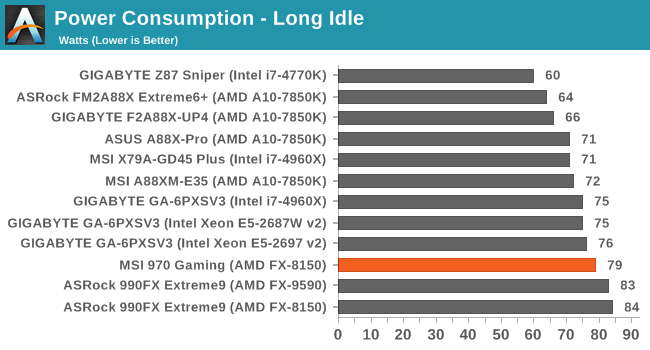
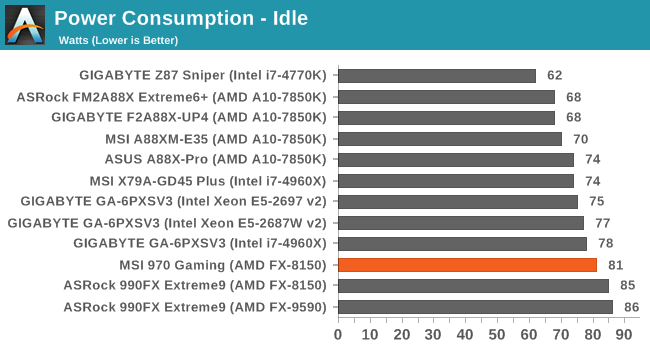
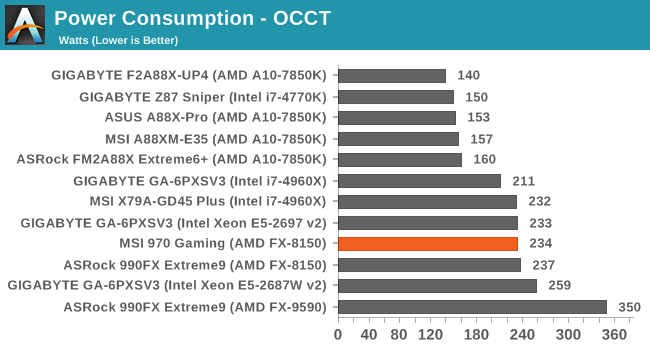
Compared to our 990FX counterpart in the similar test, the 970 Gaming does better at idle, but is relatively evenly matched at load, with the difference equating almost equally to the TDP difference of the chipsets.
Windows 7 POST Time
Different motherboards have different POST sequences before an operating system is initialized. A lot of this is dependent on the board itself, and POST boot time is determined by the controllers on board (and the sequence of how those extras are organized). As part of our testing, we look at the POST Boot Time using a stopwatch. This is the time from pressing the ON button on the computer to when Windows 7 starts loading. (We discount Windows loading as it is highly variable given Windows specific features.)
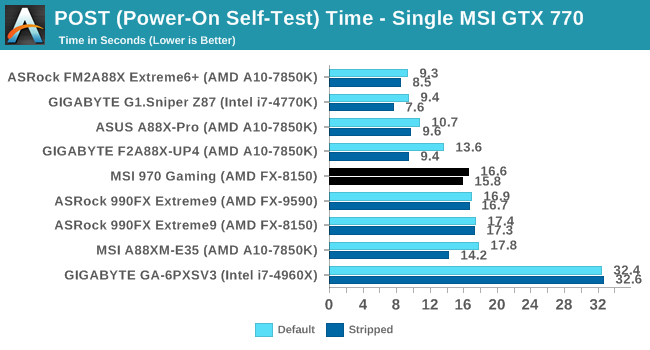
The 970 Gaming has a small leg up against the 990FX during POST.
Rightmark Audio Analyzer 6.2.5
Rightmark:AA indicates how well the sound system is built and isolated from electrical interference (either internally or externally). For this test we connect the Line Out to the Line In using a short six inch 3.5mm to 3.5mm high-quality jack, turn the OS speaker volume to 100%, and run the Rightmark default test suite at 192 kHz, 24-bit. The OS is tuned to 192 kHz/24-bit input and output, and the Line-In volume is adjusted until we have the best RMAA value in the mini-pretest. We look specifically at the Dynamic Range of the audio codec used on board, as well as the Total Harmonic Distortion + Noise.

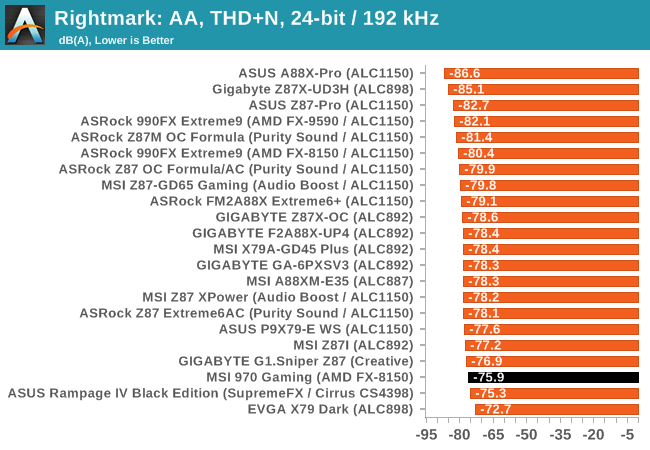
MSI’s board does slightly better in dynamic range, but falls behind a fair bit in THD+N.
USB Backup
For this benchmark, we transfer a set size of files from the SSD to the USB drive using DiskBench, which monitors the time taken to transfer. The files transferred are a 1.52 GB set of 2867 files across 320 folders – 95% of these files are small typical website files, and the rest (90% of the size) are small 30 second HD videos. In an update to pre-Z87 testing, we also run MaxCPU to load up one of the threads during the test which improves general performance up to 15% by causing all the internal pathways to run at full speed.
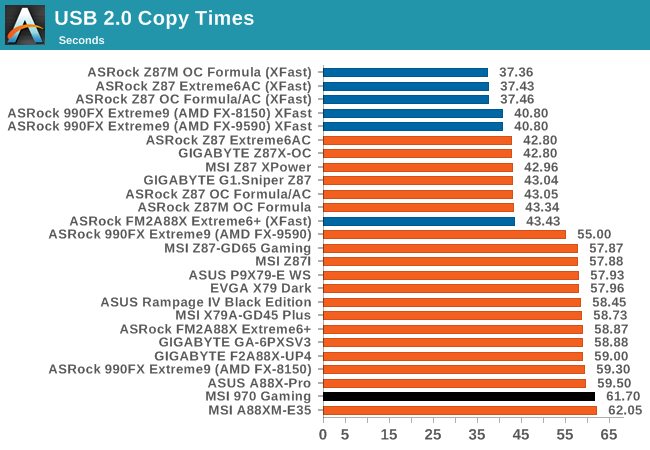
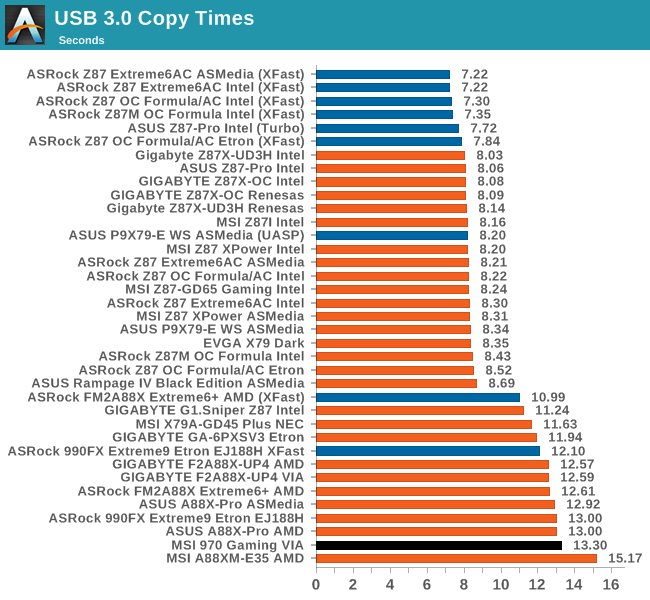
The 970 Gaming is not the best USB performer around.
DPC Latency
Deferred Procedure Call latency is a way in which Windows handles interrupt servicing. In order to wait for a processor to acknowledge the request, the system will queue all interrupt requests by priority. Critical interrupts will be handled as soon as possible, whereas lesser priority requests such as audio will be further down the line. If the audio device requires data, it will have to wait until the request is processed before the buffer is filled.
If the device drivers of higher priority components in a system are poorly implemented, this can cause delays in request scheduling and process time. This can lead to an empty audio buffer and characteristic audible pauses, pops and clicks. The DPC latency checker measures how much time is taken processing DPCs from driver invocation. The lower the value will result in better audio transfer at smaller buffer sizes. Results are measured in microseconds.
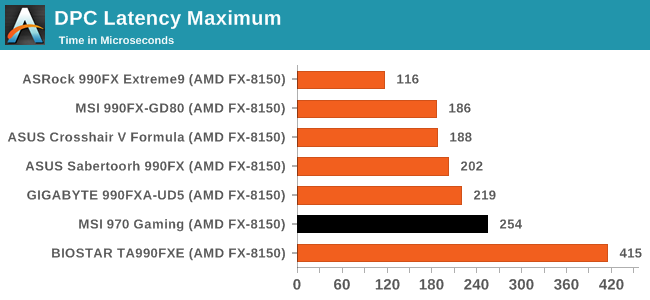
The DPC Latency is often an afterthought for cheaper motherboards, and the 254 microsecond result confirms this. This puts it in the middle of the pack for 900 series boards in general.










37 Comments
View All Comments
Stuka87 - Thursday, January 22, 2015 - link
I am actually in the market to replace my old Phenom II system (965BE @4GHz with an HD7950). And as nice as the price is for newer AMD stuff, even at the same price the performance is just not there for gaming. Too many games are poorly coded and only use two threads, so even with my current CPU two cores sit there doing nothing. With an 8320e, 6 cores sit there doing nothing. And the IPC improvements from Phenom II to current FX chips is marginal at best.Its just disappointing that gamers basically HAVE to go Intel to run any current games decently.
JarredWalton - Thursday, January 22, 2015 - link
It all depends on what you're trying to run. A very large number of games are going to be GPU limited, so much so that it really has no meaning what CPU you're running unless you're at medium to high quality settings in order to boost frame rates. We could also trot out Mantle and DX12, which should make the CPU matter even less -- but only on games that use those APIs, which is not the vast majority of games out right now or even coming this year.So yeah, if you're buying a new motherboard and CPU, it's hard to find a reason to buy an FX chip right now. If you already own one, you don't necessarily need to upgrade, but that's a different matter.
Stuka87 - Thursday, January 22, 2015 - link
Mantle is a huge boost. BF4 is near unplayable for me in multiplayer with DirectX, but runs "ok" in mantle (average 45fps, CPU limited with all four cores pegged). In that game an 8 core FX would help a lot. But then you go to a Blizzard game like Heroes of the Storm, and I am stuck with 2 cores pegged. A low end i3 outperforms my system (and FX systems) in these cases by quite a large margin.eanazag - Thursday, January 22, 2015 - link
Blizzard games always seem to be CPU heavy. It enables them to run the software decent on almost any kind of hardware. They build for Macs and many use the Intel IGP.Alexvrb - Thursday, January 22, 2015 - link
This is true and in some ways Blizzard's engines are very well optimized. They don't lean too hard on the graphics (at least at fairly moderate settings) and they look good even if you don't have a fast enough system to crank on all the eyecandy. They run well on systems with few cores, too. Both of these things tend to make them fairly laptop-friendly as well. But they're not very well threaded and the downside is that if you've got a system with relatively low per-thread performance and 4+ cores you're often going to have an unnecessarily poor experience as it simple can not take advantage of your setup.piteq - Friday, January 23, 2015 - link
I will jump in here with a question. Considering myself a WoW player and AMD supporter (that's a weird combo for sure ;-) ), I look for some options to upgrade my Phenom II X4 965 (3,5 GHz, it's not OC-ing well) and Radeon 6790 /w 1GB GDDR5 (which is noisy…). I realize, the improvement won't be huge, but I think about: Vishera 8320E, some mobo (Asus M5A99X EVO R2.0? Or maybe there are better ones for the price) and some much more silent GPU (R7 265 / R9 270? Or maybe there's something not much more expensive and better?). Do you think I will notice some justifable difference? :)HappyHubris - Friday, January 23, 2015 - link
From a X4 965 you really have no viable upgrade path.According to Anandtech's benchmark, upgrading from a X4 965 to FX 8320E would give you
HappyHubris - Friday, January 23, 2015 - link
From a X4 965 you really have no viable upgrade path.According to Anandtech's benchmark, upgrading from a X4 965 to FX 8320E would give you less than 10% improvement in average FPS:
http://www.anandtech.com/bench/product/102?vs=698
It looks like a Haswell i3 would be quite an upgrade, based on the SB i3 performance vs. AMD parts:
http://www.anandtech.com/bench/CPU/62
piteq - Monday, January 26, 2015 - link
Thank you! Eh, seems AMD marketing should never, ever show WoW results to anyone ;) Ineed, if not i3, then i5 seems to much more sensible path, especially it's not THAT more expensive thank 8320E. Well, it's just a weird, very bad for AMD case, still…FlushedBubblyJock - Sunday, February 15, 2015 - link
Buy a GTX970, you're done.